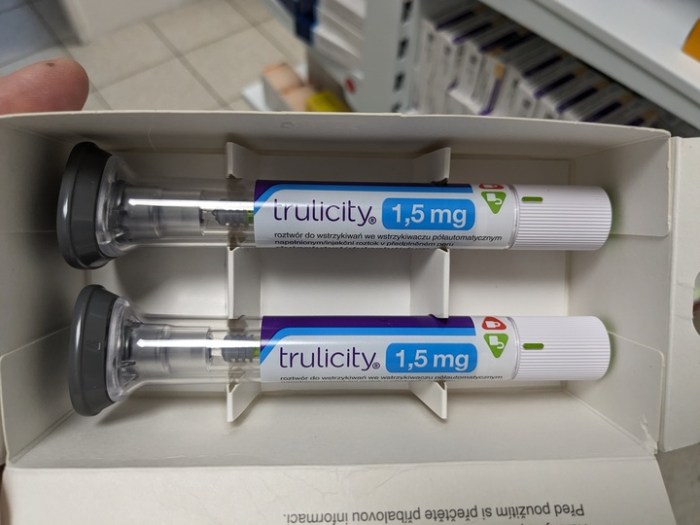Trulicity Side Effects: What Patients Should Be Aware Of

Embarking on a journey through the realm of Trulicity Side Effects: What Patients Should Be Aware Of, the narrative unfolds with intrigue and clarity, inviting readers to delve into a topic that is both informative and captivating.
The subsequent paragraph will provide a detailed and comprehensive overview of the subject matter at hand.
Overview of Trulicity

Trulicity is a prescription medication that is used to treat type 2 diabetes in adults. It belongs to a class of drugs called GLP-1 receptor agonists, which work by stimulating the release of insulin from the pancreas and reducing the amount of glucose produced by the liver.
Primary Medical Uses
Trulicity is primarily used to improve blood sugar control in adults with type 2 diabetes. It is often prescribed alongside diet and exercise to help lower A1C levels and reduce the risk of complications associated with diabetes.
- Managing blood sugar levels in adults with type 2 diabetes
- Reducing the risk of cardiovascular events in patients with established cardiovascular disease
How Trulicity Works
Trulicity works by mimicking the effects of a hormone called glucagon-like peptide-1 (GLP-1) in the body. It helps regulate blood sugar levels by increasing insulin production, slowing down digestion, and reducing glucose production in the liver.
Trulicity helps to control blood sugar levels by mimicking the effects of GLP-1 in the body.
Dosages and Administration
Trulicity is typically available in injectable pens that contain a pre-filled dose of the medication. The common dosages range from 0.75 mg to 1.5 mg once weekly, and it is usually administered under the skin of the abdomen, thigh, or upper arm.
- Common dosages: 0.75 mg and 1.5 mg once weekly
- Administered as a subcutaneous injection
- Injection sites: abdomen, thigh, or upper arm
Duration of Prescription
The duration for which Trulicity is prescribed can vary depending on the individual's response to the medication and overall health condition. In most cases, Trulicity is used as a long-term treatment to help manage blood sugar levels in patients with type 2 diabetes.
Common Side Effects
When taking Trulicity, patients may experience some common side effects. It is important to be aware of these side effects and understand how to manage them.
Gastrointestinal Issues
- Nausea
- Diarrhea
- Constipation
These gastrointestinal issues are common side effects of Trulicity. They are usually mild to moderate in severity and may improve over time as the body adjusts to the medication. Patients can manage these side effects by ensuring they are well-hydrated, eating smaller meals more frequently, and avoiding trigger foods.
Injection Site Reactions
- Redness
- Swelling
- Pain or itching at the injection site
Injection site reactions are also common when using Trulicity. These side effects are usually mild and tend to lessen with continued use. Patients can alleviate discomfort by applying a cold compress to the injection site and rotating injection sites to prevent irritation.
Hypoglycemia
- Shakiness
- Sweating
- Dizziness
Hypoglycemia, or low blood sugar, can occur with Trulicity use. This side effect is more common in patients taking other diabetes medications in addition to Trulicity. Patients can manage hypoglycemia by keeping a source of fast-acting glucose on hand, such as glucose tablets or gel, to quickly raise blood sugar levels.
Serious Side Effects

While Trulicity can be effective in managing diabetes, it is important to be aware of the serious side effects that may occur with its usage.
Hypoglycemia
Hypoglycemia, or low blood sugar, is a serious side effect of Trulicity. This can lead to symptoms such as confusion, dizziness, sweating, and even loss of consciousness. It is crucial to monitor blood sugar levels regularly while on this medication.
Pancreatitis
Pancreatitis, inflammation of the pancreas, is another serious side effect associated with Trulicity. Patients may experience severe abdominal pain, nausea, and vomiting. If these symptoms occur, immediate medical attention is necessary.
Thyroid Tumors
There have been reports of thyroid tumors, including thyroid cancer, in patients taking Trulicity. It is important to be vigilant of any unusual swelling or growth in the neck area and consult a healthcare provider promptly.
Allergic Reactions
Serious allergic reactions to Trulicity are rare but can occur. Symptoms may include rash, itching, swelling, severe dizziness, or trouble breathing. Seek emergency medical help if any signs of an allergic reaction manifest.
Cardiovascular Events
Trulicity may also increase the risk of cardiovascular events such as heart attacks or strokes. Patients with a history of heart disease should be cautious and seek immediate medical attention if they experience chest pain, shortness of breath, or sudden weakness.
Interactions and Precautions
When taking Trulicity, it is important to be aware of potential interactions with other medications or substances, as well as the precautions that should be followed to minimize risks and ensure safety.
Medications/Substances that may interact negatively with Trulicity:
- Insulin or other medications that lower blood sugar levels
- Oral diabetes medications
- Certain antibiotics
- Drugs affecting the gastrointestinal system
Precautions to take while using Trulicity:
- Avoid consuming alcohol excessively
- Inform healthcare providers of all medications being taken
- Be cautious while driving or operating machinery, especially if experiencing side effects like dizziness
- Follow a healthy diet and exercise routine as recommended
Impact of certain medical conditions on the use of Trulicity:
- Patients with a history of pancreatitis should use Trulicity with caution
- Individuals with kidney problems may require dosage adjustments
- People with a history of thyroid tumors should consult their healthcare provider before starting Trulicity
Consulting healthcare professionals before starting Trulicity:
Before initiating treatment with Trulicity, it is crucial to consult with a healthcare provider to discuss medical history, current medications, and any potential risks or interactions. This proactive approach can help ensure the safe and effective use of Trulicity.
Summary
Concluding our discussion, a final summary encapsulates the key points, leaving readers with a lasting impression of the complexities surrounding Trulicity side effects.
FAQ Guide
What are the most common side effects of Trulicity?
Common side effects of Trulicity include nausea, diarrhea, and abdominal pain.
When should patients seek immediate medical attention for Trulicity side effects?
Patients should seek immediate medical attention if they experience severe allergic reactions or signs of pancreatitis.
What precautions should patients take while using Trulicity?
Patients should be cautious about hypoglycemia and dehydration while using Trulicity.

